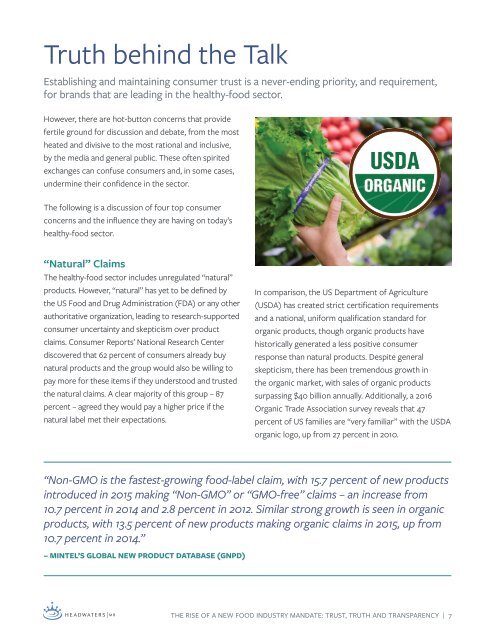Trust Truth and Transparency
Headwateres-Food-Transparency-FINAL
Headwateres-Food-Transparency-FINAL
Create successful ePaper yourself
Turn your PDF publications into a flip-book with our unique Google optimized e-Paper software.
<strong>Truth</strong> behind the Talk<br />
Establishing <strong>and</strong> maintaining consumer trust is a never-ending priority, <strong>and</strong> requirement,<br />
for br<strong>and</strong>s that are leading in the healthy-food sector.<br />
However, there are hot-button concerns that provide<br />
fertile ground for discussion <strong>and</strong> debate, from the most<br />
heated <strong>and</strong> divisive to the most rational <strong>and</strong> inclusive,<br />
by the media <strong>and</strong> general public. These often spirited<br />
exchanges can confuse consumers <strong>and</strong>, in some cases,<br />
undermine their confidence in the sector.<br />
The following is a discussion of four top consumer<br />
concerns <strong>and</strong> the influence they are having on today’s<br />
healthy-food sector.<br />
“Natural” Claims<br />
The healthy-food sector includes unregulated “natural”<br />
products. However, “natural” has yet to be defined by<br />
the US Food <strong>and</strong> Drug Administration (FDA) or any other<br />
authoritative organization, leading to research-supported<br />
consumer uncertainty <strong>and</strong> skepticism over product<br />
claims. Consumer Reports’ National Research Center<br />
discovered that 62 percent of consumers already buy<br />
natural products <strong>and</strong> the group would also be willing to<br />
pay more for these items if they understood <strong>and</strong> trusted<br />
the natural claims. A clear majority of this group – 87<br />
percent – agreed they would pay a higher price if the<br />
natural label met their expectations.<br />
In comparison, the US Department of Agriculture<br />
(USDA) has created strict certification requirements<br />
<strong>and</strong> a national, uniform qualification st<strong>and</strong>ard for<br />
organic products, though organic products have<br />
historically generated a less positive consumer<br />
response than natural products. Despite general<br />
skepticism, there has been tremendous growth in<br />
the organic market, with sales of organic products<br />
surpassing $40 billion annually. Additionally, a 2016<br />
Organic Trade Association survey reveals that 47<br />
percent of US families are “very familiar” with the USDA<br />
organic logo, up from 27 percent in 2010.<br />
“Non-GMO is the fastest-growing food-label claim, with 15.7 percent of new products<br />
introduced in 2015 making “Non-GMO” or “GMO-free” claims – an increase from<br />
10.7 percent in 2014 <strong>and</strong> 2.8 percent in 2012. Similar strong growth is seen in organic<br />
products, with 13.5 percent of new products making organic claims in 2015, up from<br />
10.7 percent in 2014.”<br />
– MINTEL’S GLOBAL NEW PRODUCT DATABASE (GNPD)<br />
THE RISE OF A NEW FOOD INDUSTRY MANDATE: TRUST, TRUTH AND TRANSPARENCY | 7



